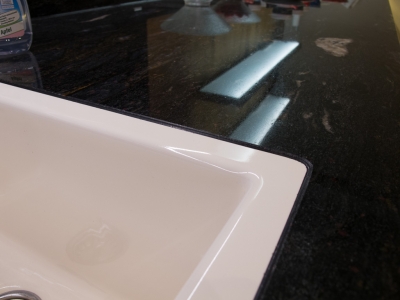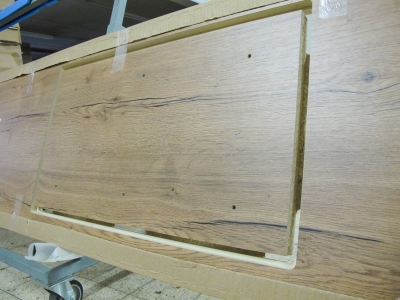S-Denken vs. N-Denken und große vs. kleine Firmen
Nach den letzten Posts kann man es sich schon fast denken, aber ich habe momentan so einen Fall von Motivationstief. Interessanterweise geht Tagebuch schreiben dann sehr gut und das hier ist ja nichts anderes. Ich kann noch von Glück sagen dass nicht alles schief gelaufen ist sonst wäre ich wohl auf Wochen unzurechnungsfähig, dieses Experiment hat tatsächlich funktioniert und illustriert eben sehr gut den Unterschied zwischen Sensor-(S) und Intuitiven (I) Typen.
Um zu verstehen worum es hier geht muss ich etwas ausholen: Bei Einbauspülbecken in Küchenarbeitsplatten gibt es zwei Möglichkeiten diese einzubauen: aufgelegt und flächenbündig, wo also kein Rand hervorsteht:
Das Problem dabei war jahrelang, dass dies nur in wasserfesten Materialien realisierbar war, denn dafür muss man einen Falz in die Platte fräsen und bei einer Spanplatte bekommt man die Schnittkante dann nicht dicht und sie quillt unweigerlich auf. Es gab Plattenhersteller, die Lösungen für werkseitig eingebaute Becken angeboten haben, aber diese waren teuer und auf die Becken beschränkt die diese im Sortiment hatten. Bis irgendwann jemand diese Idee hatte:
Mit dieser Einbautechnik kann man jedes beliebige flächenbündige Becken recht günstig in die klassischen Arbeitsplatten einbauen und unser Küchenlieferant hat diese Technik dann auch ins Sortiment aufgenommen. (Allerdings etwas vereinfacht, statt des Falzes liefen sie Leisten zum Anschrauben mit). Was jetzt folgt, ist mal wieder ein klassisches Beispiel für die Dynamik großer Firmen und den grundsätzlichen Unterschied zwischen Sensoren und Intuitiven. Mein Vater hat jedenfalls ein solch eingebautes Becken verkauft, unser Lieferant sagte dann aber, sie hätten dieses Modell nicht im Sortiment und könnten deshalb den Ausschnitt nicht. Gelinde gesagt ist das Quatsch. Der einzige Unterschied ist das das Modell 850 mm breit ist und das im Sortiment 900 mm, es ist also ein einziger Wert in der Datei zu ändern. Aber das ist nicht vorgesehen und das geht dann einfach nicht.
Jetzt hatte ich aber dieses Musterstück eines anderen Herstellers und das gelbe Füllmaterial kam mir bekannt vor, das sah nämlich sehr stark aus wie das Gießharz was ich im Modellbau verwendet habe. Und wenn man sich das Stück genauer ansieht dann ist auch klar wie es gemacht wurde: Zuerst von der Unterseite eine Nut bis auf den Schichtstoff eingefräst, dann ausgegossen und im letzten Schritt von oben den Ausschnitt mit Falz eingefräst. Jetzt habe ich seit letztem Jahr eine CNC-Portalfräse mit einer Bearbeitungsfläche von 100x110 cm, also groß genug für diesen Ausschnitt.
Als ich meinem Chefmonteur (müsste ein ESTP sein) von der Sache erzählt habe war er sehr skeptisch und brachte Argumente wie "wenn das so einfach wäre, würde unser großer Mittbewerber mit 50 Leuten in der Werkstatt und Profi-Maschinen das auch machen, du hast ja nur eine Hobbyfräse" oder "wenn du nicht genau bis auf den Resopal fräst wird das nicht dicht und gibt nur Probleme hinterher" und "das ist so viel Aufwand, damit kann man nichts verdienen" und "der Kunde hätte auch das andere Becken gekauft" und so weiter. Gut, meine Fräse hat nur 5.000 Euro und keine 50.000 gekostet (NB: das war sowieso doppelt so viel wie ich ursprünglich ausgeben wollte, aber im Hinblick auf die Einsatzmöglichkeiten habe ich eben dann nicht an der falschen Stelle gespart), aber das äußert sich vor allem in der Motorisierung, Geschwindigkeit und der Größe, nicht an der Präzision.
Für mich steht da etwas ganz anderes im Vordergrund: Die Möglichkeit etwas neues auszuprobieren und meine Fähigkeiten zu erweitern, in dem Fall muss ich zwar vielleicht nicht kostendeckend, aber zumindest nicht umsonst arbeiten. Soweit ich das vorher absehen konnte ist das kein Problem so genau zu fräsen, die Maschine hat ja eine Auflageplatte die ich exakt plan gefräst habe und ich kann das Werkstück fest darauf schrauben. Und mit dem Gießharz habe ich auch schon gearbeitet, wenn auch nicht in solchen Mengen und teuer ist das auch nicht. Wenn natürlich alles schief geht, dann sind 20€ Gießharz weg, die Platte für 200 und wahrscheinlich am schlimmsten ist das wir nicht pünktlich liefern können, also ein gewisses Risiko ist da. Es gibt ein Interview mit Adam Savage auf Youtube was ich leider nicht mehr finde. Dort sagt er nämlich genau das: Er hat in seiner Karriere möglichst viele solcher Jobs gemacht um neues Auszuprobieren und seine Fähigkeiten zu erweitern.
Die eigentliche Umsetzung war dann kein Problem: Im CAD den Ausschnitt und die Nut zu modellieren und die Fräsdaten zu erzeugen. Etwas unnannehmlich war dann die Tatsache dass die Fräse in der Wohnung steht und das Zimmer ein klein wenig zu klein für eine 3,20 Meter lange Platte ist, aber typischerweise habe ich das Ding so verkabelt dass es nicht an genau diese Position gebunden ist, ich habe die Maschine also kurzerhand auf Rollwagen gestellt (klar, CNC-gefräst ..), gedreht und die Platte durch das Fenster hereingeschoben. Beim Fräsen war ich dann auch extra vorsichtig und habe alles dreimal gecheckt, einen Crash konnte ich absolut nicht gebrauchen und ich habe auch nur einen extralangen 12er Fräser. Ergo hat alles etwas länger gedauert und war nicht kostendeckend, aber es hat schlussendlich prima funktioniert: Ausfräsen, die letzten 1/10 mm in einzelnen Schritten bis man genau am Belag ist, Harz in mehreren Portionen anrühren und eingießen (das waren 1,5 Liter ..), am nächsten Tag umdrehen und fertig fräsen.
Sollte das also jetzt häufiger vorkommen, brauche ich tatsächlich nur die Größenparameter zu ändern, die Frässtrategie mit Vorschüben und Zustellungen bleibt ja gleich und dann ist das auch locker kostendeckend. Gut, es ist nicht alles zu 100% glatt gelaufen: Ich hatte die Position des Ausschnitts von einer Granitplatte übernommen und nachdem alles vergossen war ist mir aufgefallen dass das eine grifflose Küche war wo der Arbeitsplattenüberstand kleiner ist. Man hätte den Ausschnitt dann tatsächlich etwas weiter nach hinten verlegen können, der Granitlieferant macht das aber auch nicht wie ich dann mitten in der Nacht zu meiner Erleichterung herausgefunden habe. Tja, und irgendwie hatte ich mich bei der Bestellung des Harzes vertan, ich kam nur auf einen Liter bei der ersten Mengenberechnung und das war zu wenig. Das war aber - typisch INTJ - kein Problem denn ich hatte noch ein angefangenes 2-Liter-Gebinde vom Modellbau und für den Fall das es nicht reicht war das bereits als Ausweichlösung eingeplant.
Und schließlich noch zu dem Argument warum unser Mitbewerber das nicht macht: Die haben 50 Leute in der Werkstatt, eine extra Konstruktionsabteilung, den Verkauf und die Geschäftsleitung. Wer sollte denn auf die Idee kommen das sie so etwas selbst können und es zu machen? Die Leute im Verkauf gehen den einfachen Weg und verkaufen das was es fertig gibt. Ohne einen Anstoß wird sich niemand aus der Konstruktionsabteilung daran geben, die Werkstatt baut nur das was sie soll und die Geschäftsleitung weiß davon nichts. Das ist eben der ganz große Unterschied wenn alle diese Abteilungen in Personalunion vereinigt sind, dann ist man einfach so flexibel so etwas auszuprobieren. Und es braucht eben einen Intuitiven der die Herausforderung "kann ich das auch?" sucht um das dann tatsächlich zu machen.





Kommentare
Ansicht der Kommentare: Linear | Verschachtelt